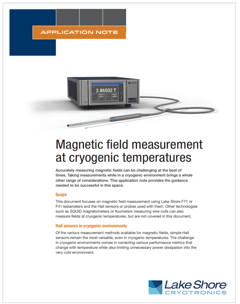With the growth in use, complexity, and strength of superconducting magnets, the need to characterize the fields they produce is growing as well. There are a multitude of complicating factors that make this a challenging prospect. There are many options for magnetic field measurement instruments for this situation, but how do you know whether the reading you take it really measuring what you think you’re measuring?
Hall-based sensor technology paired with a gaussmeter or teslameter is a popular method for making field measurements in general, and can also be useful at cryogenic temperatures. This measurement combo is very flexible, has a very large range of measurable field strengths, and is relatively inexpensive compared to other possible solutions. It just requires a little thought about the impact that a cryogenic environment will have on measurement performance.
 This new application note attempts to highlight some of the common challenges and errors that could be encountered in cryogenic environments and suggests ways to work around them. Lake Shore Cryotronics F71 and F41 teslameters include many features that either do this automatically or at least make it easier.
This new application note attempts to highlight some of the common challenges and errors that could be encountered in cryogenic environments and suggests ways to work around them. Lake Shore Cryotronics F71 and F41 teslameters include many features that either do this automatically or at least make it easier.
In some cases, it is not feasible to solve every problem that comes with cryogenic field measurement. However, being aware of these limitations is critical to understanding what you might actually be measuring.
